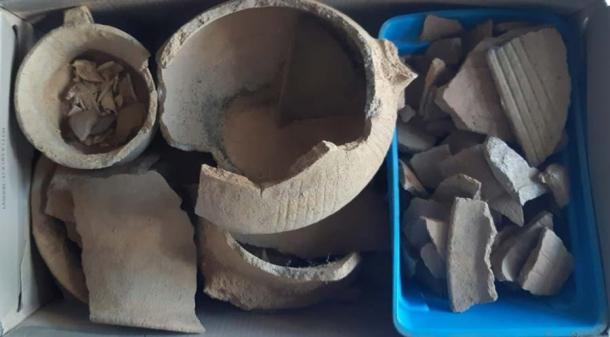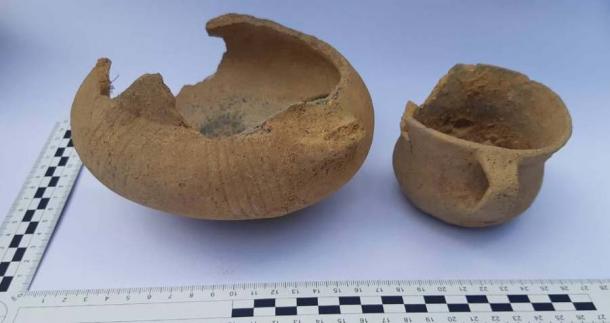
Polish Children Unearth Ancient Lusatian Graves In Sandpit
A group of Polish children digging in a playground sandpit made the unexpected, and quite morbid, discovery of a Bronze Age Lusatian grave. The children are fine, but we adults should be asking if this unearthing is a further clue to the existence of a greater unexplored ancient sacred site?
Tuchola Żarska is a village in western Poland approximately 8 kilometers (5 miles) east of Lubsko, and before 1945 the region was part of Germany. It was here that children recently dug up Bronze Age burials while digging in a playground, according to a report in The First News.
Local archaeology inspector Marcin Kosowicz said the human remains discovered inside the burial urns are thought to belong to the Lusatian culture. This means the sacred deposits date back to about 1100 to 700 BC. Kosowicz explained that the removal of “a considerable part of humus took place during the leveling of the ground for the construction of the playing field with heavy equipment.” The children simply scraped of the topsoil to reveal the timeworn earthen tomb.
- Bronze Age Sword Found at Secret New Site in Czech Republic
- Sloup Castle: Bohemia’s Salt Trade Defense, Hermitage and Tourist Spot
An Apparently Isolated, But Potentially ‘Linked’ Discovery
What is being called a “grim discovery” was made just below the surface of a sandpit in a children’s playground in the village of Tuchola Żarska, after local schoolchildren began digging with a bucket and spade. Marcin Kosowicz said that while innocently digging in a sandpit the children unearthed ancient urns inside “one or two extensive corpse graves” of the Lusatian culture community.

Surprising find of burial urns just under the surface of the children’s sandpit in Poland. (© LWKZ)
The Lusatian culture existed in the later Bronze Age and early Iron Age in what is today Poland and they also inhabited parts of the Czechia, Slovakia, eastern Germany and western Ukraine. Professor Kosowicz thinks the removal of earth for the new playground revealed the ancient grave, and he also said that he suspects the location of the burials is perhaps linked to an earlier archaeological site that is located nearby.
What Might Lie Beneath The Sandpit?
The archaeologist offers geodetic evidence to support the notion that the newly discovered site is associated with an earlier site. Kosowicz said the fact that its location is marked on a map on a scale of 1:25 000, “which is characterized by low precision,” it is possible that the grave that the children discovered is closely connected to this site that is listed in the provincial heritage protection register. However, the origins and purpose of this earlier site are shrouded in as much mystery as the new burial site.
According to The First News, many years ago a pond and a new fence was built on the premises of the neighboring State Agricultural Farm. At that time “bronze artifacts and ceramic vessels were discovered.” However, Kosowicz said archaeologists have never been able to establish the “further fate of these artifacts”. Might it be the case that there exists even more archaeology beneath the soil between the two sites?
- Unique and Decorative Burial Urns with Faces in the Pomeranian Culture
- The Battle Axe Culture: Piecing Together the Age of Crushed Skulls

Lusatian culture pottery containing human remains were discovered near the surface. (© LWKZ)
Does The Future Hold Gold?
Whether a greater Lusatian burial complex exists at this site, or not, a full excavation of the sandpit will no doubt be featured here soon. What must be exciting archaeologists in Poland is that a fairly solid archaeological pattern is that Lusatian burial urns are generally accompanied by up to 40 secondary vessels. And in the case of the Pomerania site in Poland, and at Seddin and Eberswalde in Brandenburg, thousands of graves were excavated containing metal artifacts, glass beads and gold jewelry.
If I do cover this article in the near future the first question I will be asking is will the child who dug the hole in the sandpit be getting a finder’s fee? And speaking of that lucky little digger, perhaps the most significant result from the discovery of the graves is that Poland just ‘made’ a new future archaeologist. The young boy who made the discovery told The First News that he now wants “to become an archaeologist” when he grows up.
Top image: The sandpit where the Lusatian graves were discovered. Source: zarynaszemiasto / The First News
By Ashley Cowie
















Comments
The site or something found needs to be named after the kid who wants to be an archaeologist.
SD Black